Comprehensive Examination of International Business Concepts
VerifiedAdded on 2022/08/17
|27
|7305
|15
Homework Assignment
AI Summary
This document presents a comprehensive set of exam questions and answers focused on international business and business development. It addresses key concepts such as ownership advantages in the context of foreign direct investment (FDI), exploring how companies leverage competitive benefits for international expansion. The document then examines the advantages and disadvantages of joint ventures as an international entry mode, including their limitations for firms pursuing a global strategy. It delves into firm-specific and industry-specific factors driving cross-border mergers and acquisitions, along with reasons for acquisition failures. Furthermore, the document discusses the benefits and costs of R&D internationalization, including the rationale behind establishing R&D centers in countries with weak intellectual property protection. Finally, it analyzes the advantages and disadvantages of a transnational strategy, highlighting its unique aspects and the organizational structure needed to support it. The document is a valuable resource for students studying international business, offering insights into market entry strategies, global expansion, and the dynamics of international business operations.
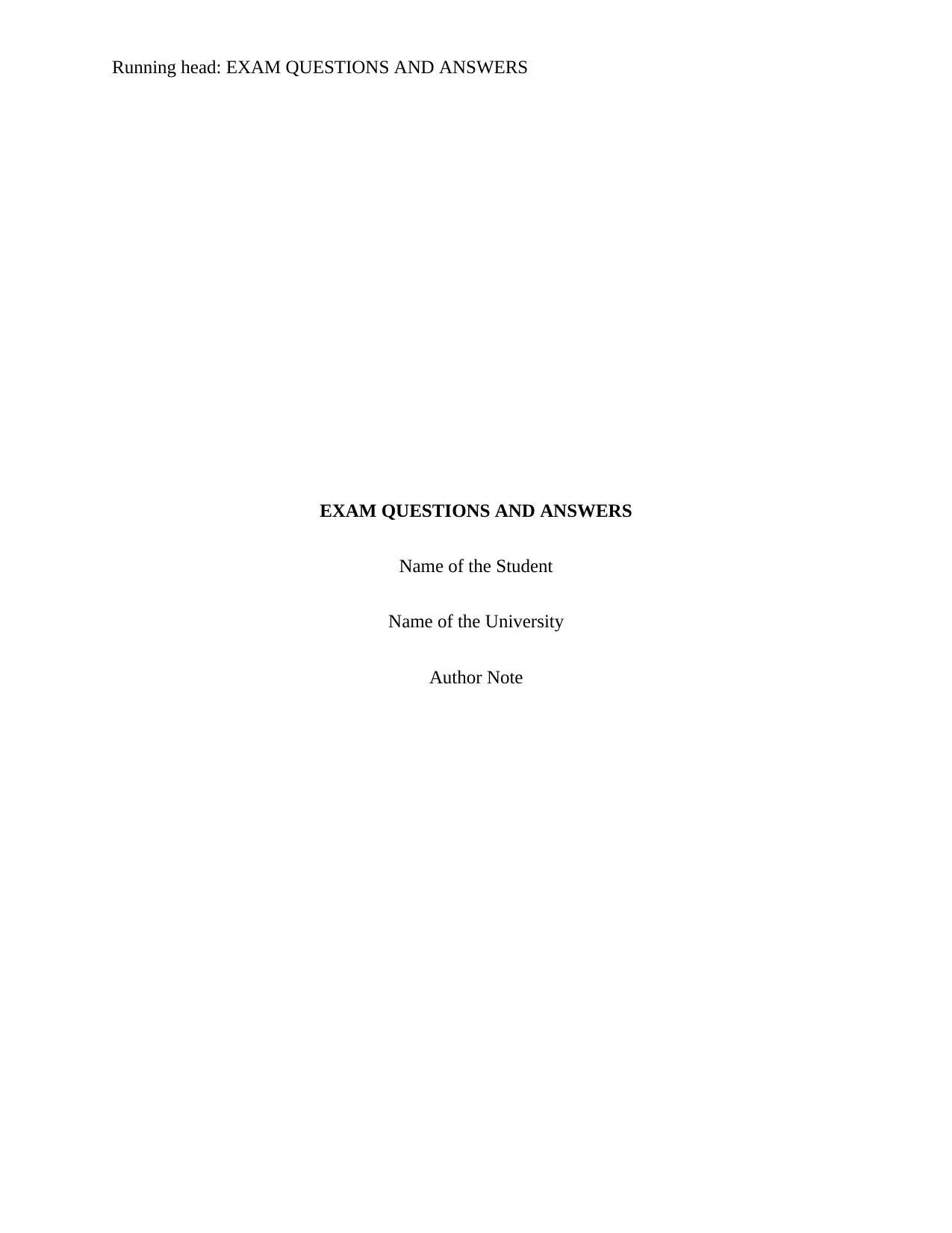
Running head: EXAM QUESTIONS AND ANSWERS
EXAM QUESTIONS AND ANSWERS
Name of the Student
Name of the University
Author Note
EXAM QUESTIONS AND ANSWERS
Name of the Student
Name of the University
Author Note
Paraphrase This Document
Need a fresh take? Get an instant paraphrase of this document with our AI Paraphraser
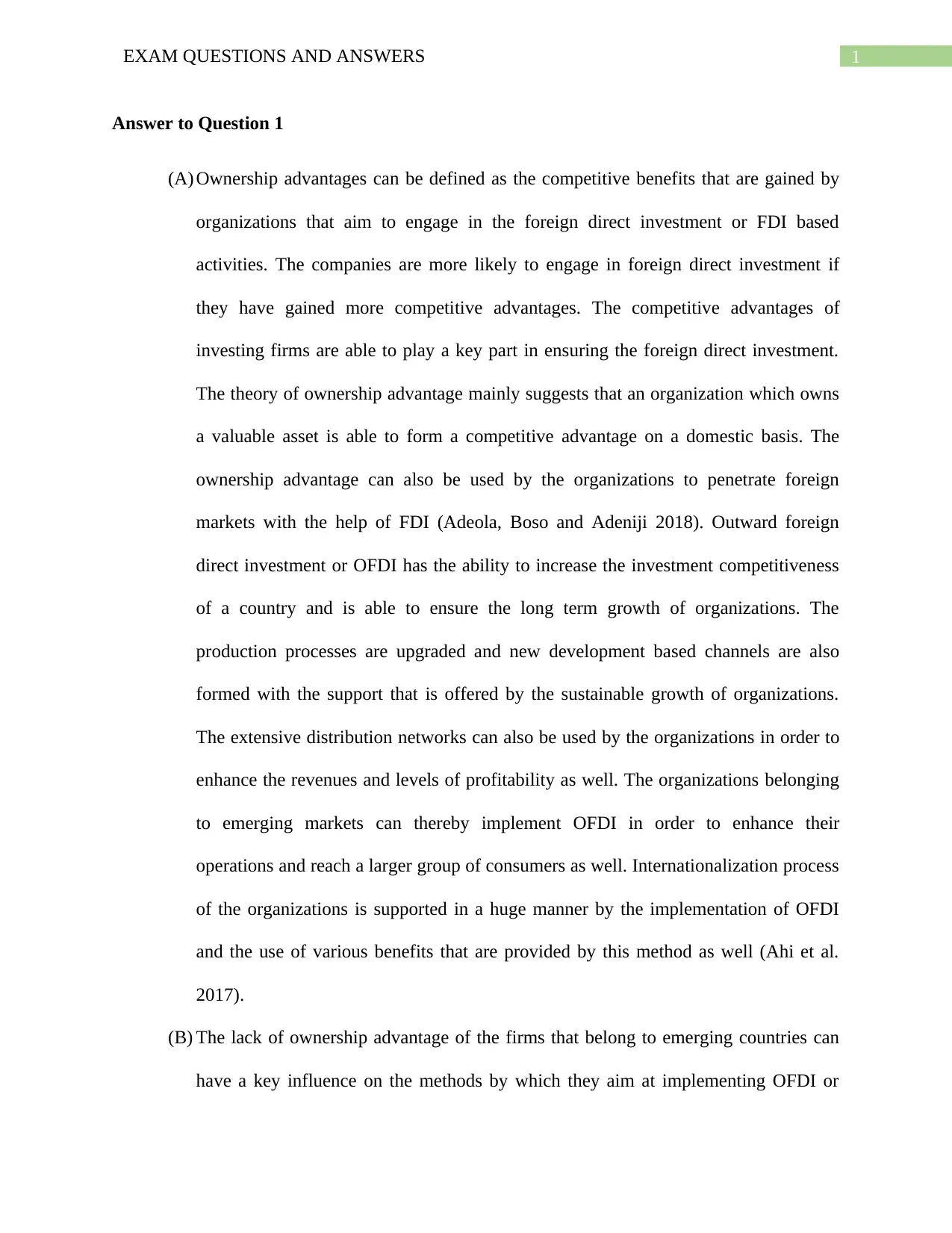
1EXAM QUESTIONS AND ANSWERS
Answer to Question 1
(A) Ownership advantages can be defined as the competitive benefits that are gained by
organizations that aim to engage in the foreign direct investment or FDI based
activities. The companies are more likely to engage in foreign direct investment if
they have gained more competitive advantages. The competitive advantages of
investing firms are able to play a key part in ensuring the foreign direct investment.
The theory of ownership advantage mainly suggests that an organization which owns
a valuable asset is able to form a competitive advantage on a domestic basis. The
ownership advantage can also be used by the organizations to penetrate foreign
markets with the help of FDI (Adeola, Boso and Adeniji 2018). Outward foreign
direct investment or OFDI has the ability to increase the investment competitiveness
of a country and is able to ensure the long term growth of organizations. The
production processes are upgraded and new development based channels are also
formed with the support that is offered by the sustainable growth of organizations.
The extensive distribution networks can also be used by the organizations in order to
enhance the revenues and levels of profitability as well. The organizations belonging
to emerging markets can thereby implement OFDI in order to enhance their
operations and reach a larger group of consumers as well. Internationalization process
of the organizations is supported in a huge manner by the implementation of OFDI
and the use of various benefits that are provided by this method as well (Ahi et al.
2017).
(B) The lack of ownership advantage of the firms that belong to emerging countries can
have a key influence on the methods by which they aim at implementing OFDI or
Answer to Question 1
(A) Ownership advantages can be defined as the competitive benefits that are gained by
organizations that aim to engage in the foreign direct investment or FDI based
activities. The companies are more likely to engage in foreign direct investment if
they have gained more competitive advantages. The competitive advantages of
investing firms are able to play a key part in ensuring the foreign direct investment.
The theory of ownership advantage mainly suggests that an organization which owns
a valuable asset is able to form a competitive advantage on a domestic basis. The
ownership advantage can also be used by the organizations to penetrate foreign
markets with the help of FDI (Adeola, Boso and Adeniji 2018). Outward foreign
direct investment or OFDI has the ability to increase the investment competitiveness
of a country and is able to ensure the long term growth of organizations. The
production processes are upgraded and new development based channels are also
formed with the support that is offered by the sustainable growth of organizations.
The extensive distribution networks can also be used by the organizations in order to
enhance the revenues and levels of profitability as well. The organizations belonging
to emerging markets can thereby implement OFDI in order to enhance their
operations and reach a larger group of consumers as well. Internationalization process
of the organizations is supported in a huge manner by the implementation of OFDI
and the use of various benefits that are provided by this method as well (Ahi et al.
2017).
(B) The lack of ownership advantage of the firms that belong to emerging countries can
have a key influence on the methods by which they aim at implementing OFDI or
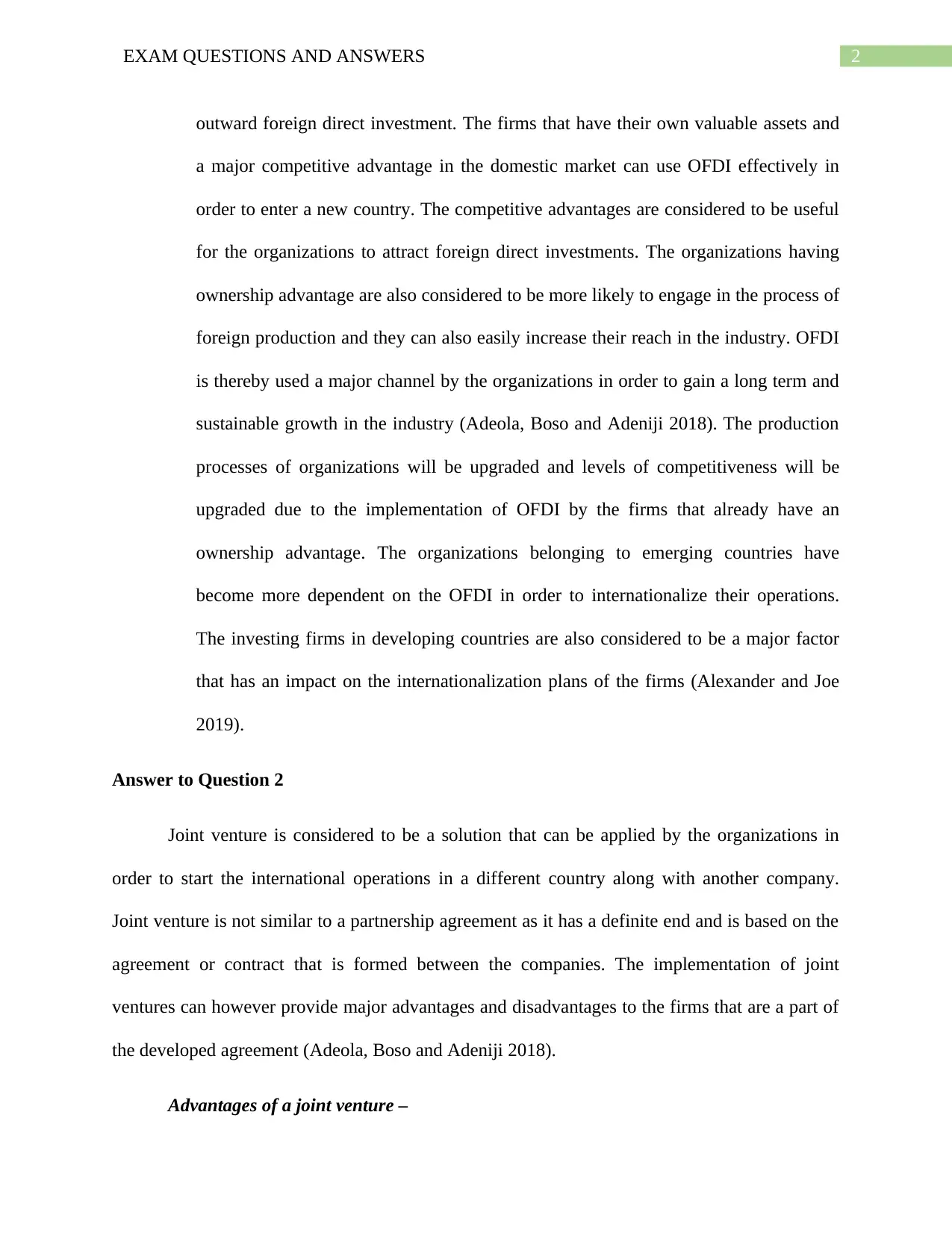
2EXAM QUESTIONS AND ANSWERS
outward foreign direct investment. The firms that have their own valuable assets and
a major competitive advantage in the domestic market can use OFDI effectively in
order to enter a new country. The competitive advantages are considered to be useful
for the organizations to attract foreign direct investments. The organizations having
ownership advantage are also considered to be more likely to engage in the process of
foreign production and they can also easily increase their reach in the industry. OFDI
is thereby used a major channel by the organizations in order to gain a long term and
sustainable growth in the industry (Adeola, Boso and Adeniji 2018). The production
processes of organizations will be upgraded and levels of competitiveness will be
upgraded due to the implementation of OFDI by the firms that already have an
ownership advantage. The organizations belonging to emerging countries have
become more dependent on the OFDI in order to internationalize their operations.
The investing firms in developing countries are also considered to be a major factor
that has an impact on the internationalization plans of the firms (Alexander and Joe
2019).
Answer to Question 2
Joint venture is considered to be a solution that can be applied by the organizations in
order to start the international operations in a different country along with another company.
Joint venture is not similar to a partnership agreement as it has a definite end and is based on the
agreement or contract that is formed between the companies. The implementation of joint
ventures can however provide major advantages and disadvantages to the firms that are a part of
the developed agreement (Adeola, Boso and Adeniji 2018).
Advantages of a joint venture –
outward foreign direct investment. The firms that have their own valuable assets and
a major competitive advantage in the domestic market can use OFDI effectively in
order to enter a new country. The competitive advantages are considered to be useful
for the organizations to attract foreign direct investments. The organizations having
ownership advantage are also considered to be more likely to engage in the process of
foreign production and they can also easily increase their reach in the industry. OFDI
is thereby used a major channel by the organizations in order to gain a long term and
sustainable growth in the industry (Adeola, Boso and Adeniji 2018). The production
processes of organizations will be upgraded and levels of competitiveness will be
upgraded due to the implementation of OFDI by the firms that already have an
ownership advantage. The organizations belonging to emerging countries have
become more dependent on the OFDI in order to internationalize their operations.
The investing firms in developing countries are also considered to be a major factor
that has an impact on the internationalization plans of the firms (Alexander and Joe
2019).
Answer to Question 2
Joint venture is considered to be a solution that can be applied by the organizations in
order to start the international operations in a different country along with another company.
Joint venture is not similar to a partnership agreement as it has a definite end and is based on the
agreement or contract that is formed between the companies. The implementation of joint
ventures can however provide major advantages and disadvantages to the firms that are a part of
the developed agreement (Adeola, Boso and Adeniji 2018).
Advantages of a joint venture –
⊘ This is a preview!⊘
Do you want full access?
Subscribe today to unlock all pages.

Trusted by 1+ million students worldwide
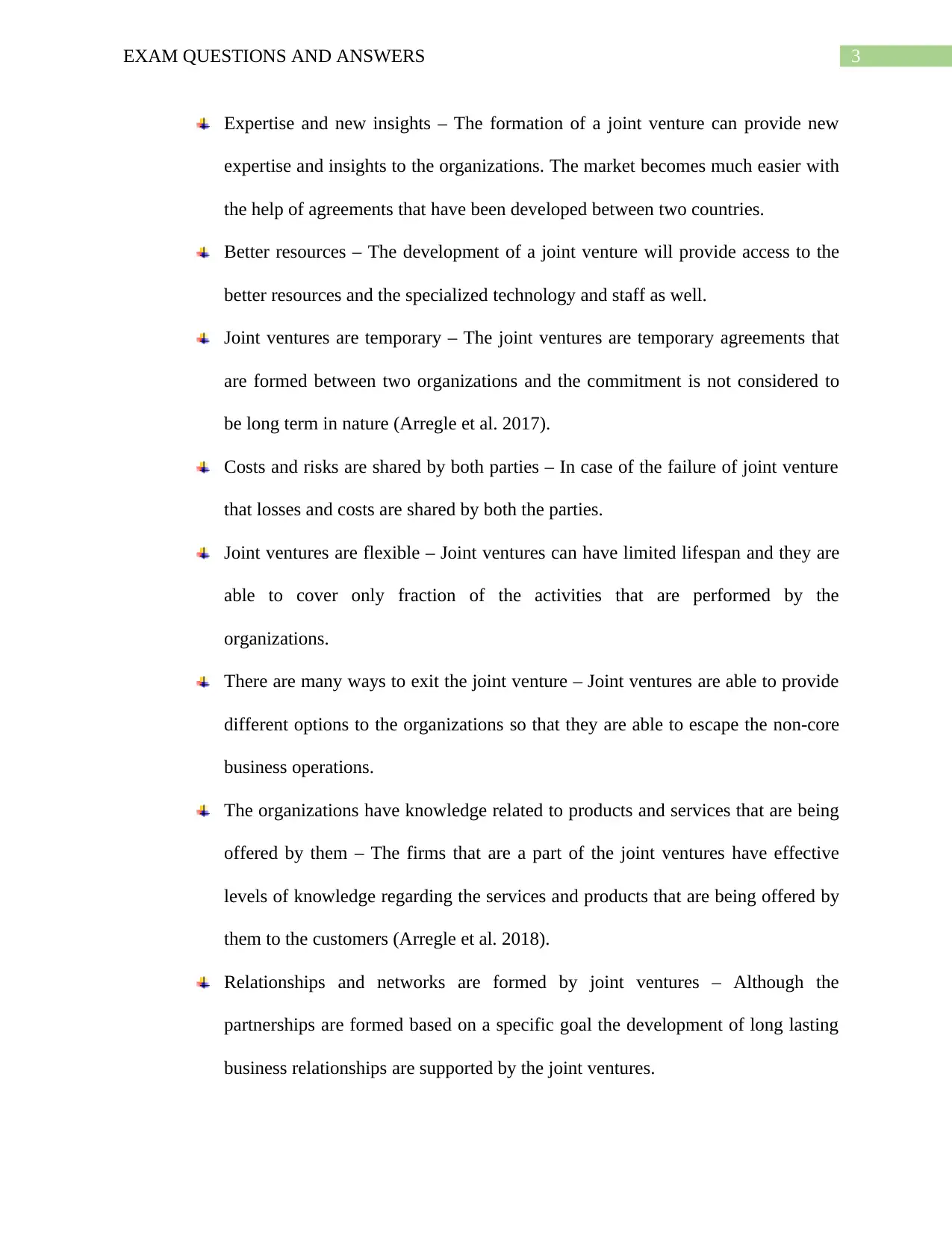
3EXAM QUESTIONS AND ANSWERS
Expertise and new insights – The formation of a joint venture can provide new
expertise and insights to the organizations. The market becomes much easier with
the help of agreements that have been developed between two countries.
Better resources – The development of a joint venture will provide access to the
better resources and the specialized technology and staff as well.
Joint ventures are temporary – The joint ventures are temporary agreements that
are formed between two organizations and the commitment is not considered to
be long term in nature (Arregle et al. 2017).
Costs and risks are shared by both parties – In case of the failure of joint venture
that losses and costs are shared by both the parties.
Joint ventures are flexible – Joint ventures can have limited lifespan and they are
able to cover only fraction of the activities that are performed by the
organizations.
There are many ways to exit the joint venture – Joint ventures are able to provide
different options to the organizations so that they are able to escape the non-core
business operations.
The organizations have knowledge related to products and services that are being
offered by them – The firms that are a part of the joint ventures have effective
levels of knowledge regarding the services and products that are being offered by
them to the customers (Arregle et al. 2018).
Relationships and networks are formed by joint ventures – Although the
partnerships are formed based on a specific goal the development of long lasting
business relationships are supported by the joint ventures.
Expertise and new insights – The formation of a joint venture can provide new
expertise and insights to the organizations. The market becomes much easier with
the help of agreements that have been developed between two countries.
Better resources – The development of a joint venture will provide access to the
better resources and the specialized technology and staff as well.
Joint ventures are temporary – The joint ventures are temporary agreements that
are formed between two organizations and the commitment is not considered to
be long term in nature (Arregle et al. 2017).
Costs and risks are shared by both parties – In case of the failure of joint venture
that losses and costs are shared by both the parties.
Joint ventures are flexible – Joint ventures can have limited lifespan and they are
able to cover only fraction of the activities that are performed by the
organizations.
There are many ways to exit the joint venture – Joint ventures are able to provide
different options to the organizations so that they are able to escape the non-core
business operations.
The organizations have knowledge related to products and services that are being
offered by them – The firms that are a part of the joint ventures have effective
levels of knowledge regarding the services and products that are being offered by
them to the customers (Arregle et al. 2018).
Relationships and networks are formed by joint ventures – Although the
partnerships are formed based on a specific goal the development of long lasting
business relationships are supported by the joint ventures.
Paraphrase This Document
Need a fresh take? Get an instant paraphrase of this document with our AI Paraphraser
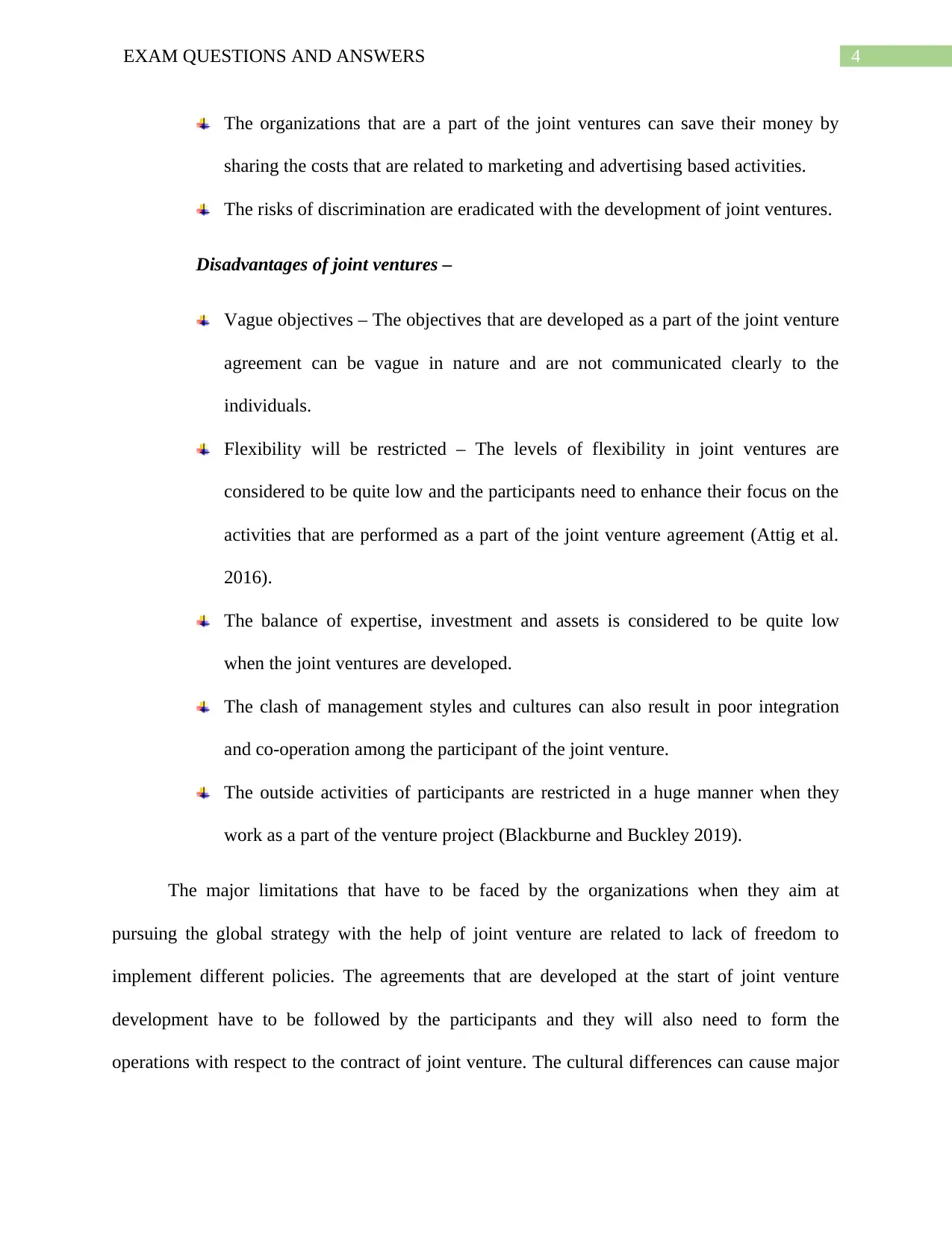
4EXAM QUESTIONS AND ANSWERS
The organizations that are a part of the joint ventures can save their money by
sharing the costs that are related to marketing and advertising based activities.
The risks of discrimination are eradicated with the development of joint ventures.
Disadvantages of joint ventures –
Vague objectives – The objectives that are developed as a part of the joint venture
agreement can be vague in nature and are not communicated clearly to the
individuals.
Flexibility will be restricted – The levels of flexibility in joint ventures are
considered to be quite low and the participants need to enhance their focus on the
activities that are performed as a part of the joint venture agreement (Attig et al.
2016).
The balance of expertise, investment and assets is considered to be quite low
when the joint ventures are developed.
The clash of management styles and cultures can also result in poor integration
and co-operation among the participant of the joint venture.
The outside activities of participants are restricted in a huge manner when they
work as a part of the venture project (Blackburne and Buckley 2019).
The major limitations that have to be faced by the organizations when they aim at
pursuing the global strategy with the help of joint venture are related to lack of freedom to
implement different policies. The agreements that are developed at the start of joint venture
development have to be followed by the participants and they will also need to form the
operations with respect to the contract of joint venture. The cultural differences can cause major
The organizations that are a part of the joint ventures can save their money by
sharing the costs that are related to marketing and advertising based activities.
The risks of discrimination are eradicated with the development of joint ventures.
Disadvantages of joint ventures –
Vague objectives – The objectives that are developed as a part of the joint venture
agreement can be vague in nature and are not communicated clearly to the
individuals.
Flexibility will be restricted – The levels of flexibility in joint ventures are
considered to be quite low and the participants need to enhance their focus on the
activities that are performed as a part of the joint venture agreement (Attig et al.
2016).
The balance of expertise, investment and assets is considered to be quite low
when the joint ventures are developed.
The clash of management styles and cultures can also result in poor integration
and co-operation among the participant of the joint venture.
The outside activities of participants are restricted in a huge manner when they
work as a part of the venture project (Blackburne and Buckley 2019).
The major limitations that have to be faced by the organizations when they aim at
pursuing the global strategy with the help of joint venture are related to lack of freedom to
implement different policies. The agreements that are developed at the start of joint venture
development have to be followed by the participants and they will also need to form the
operations with respect to the contract of joint venture. The cultural differences can cause major
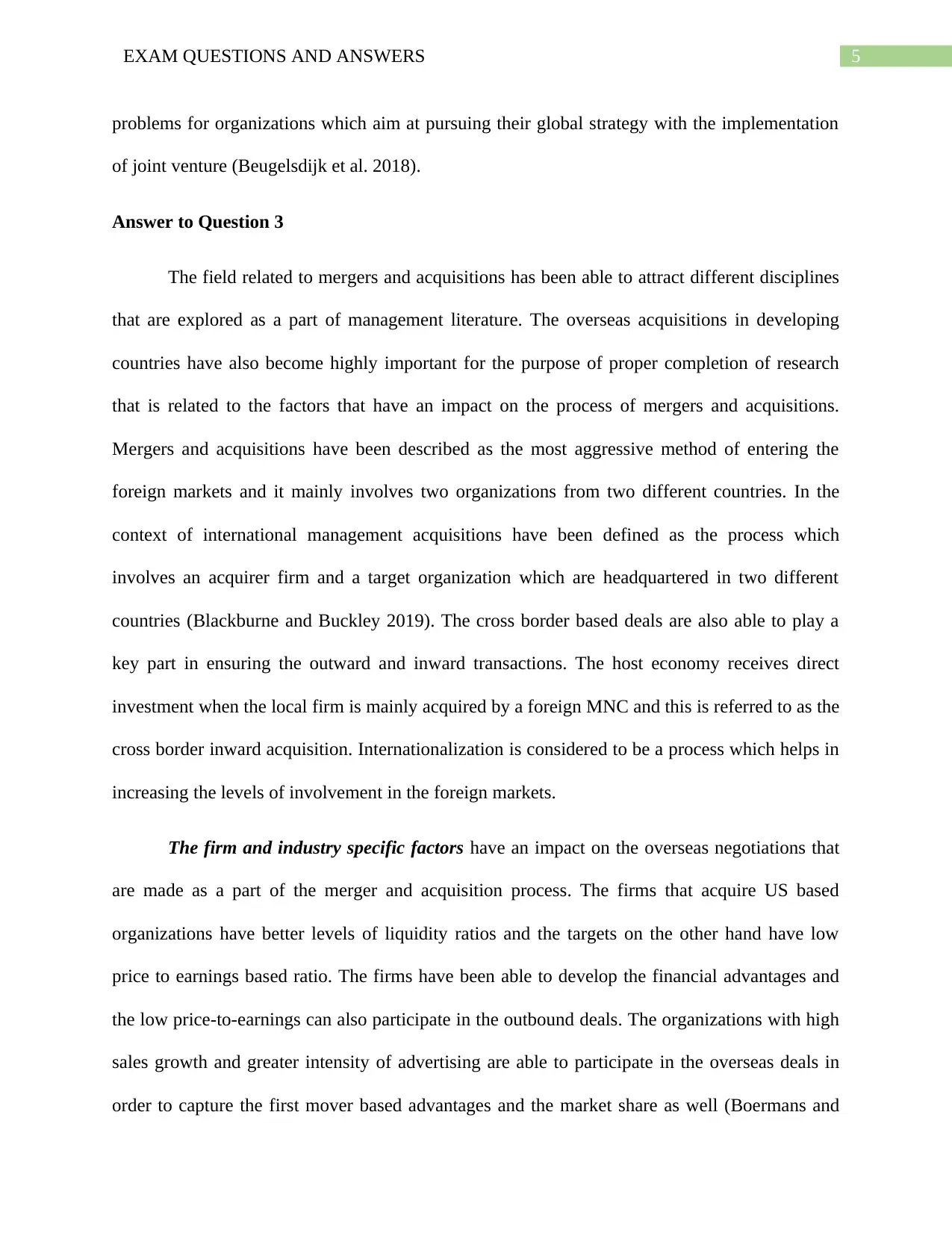
5EXAM QUESTIONS AND ANSWERS
problems for organizations which aim at pursuing their global strategy with the implementation
of joint venture (Beugelsdijk et al. 2018).
Answer to Question 3
The field related to mergers and acquisitions has been able to attract different disciplines
that are explored as a part of management literature. The overseas acquisitions in developing
countries have also become highly important for the purpose of proper completion of research
that is related to the factors that have an impact on the process of mergers and acquisitions.
Mergers and acquisitions have been described as the most aggressive method of entering the
foreign markets and it mainly involves two organizations from two different countries. In the
context of international management acquisitions have been defined as the process which
involves an acquirer firm and a target organization which are headquartered in two different
countries (Blackburne and Buckley 2019). The cross border based deals are also able to play a
key part in ensuring the outward and inward transactions. The host economy receives direct
investment when the local firm is mainly acquired by a foreign MNC and this is referred to as the
cross border inward acquisition. Internationalization is considered to be a process which helps in
increasing the levels of involvement in the foreign markets.
The firm and industry specific factors have an impact on the overseas negotiations that
are made as a part of the merger and acquisition process. The firms that acquire US based
organizations have better levels of liquidity ratios and the targets on the other hand have low
price to earnings based ratio. The firms have been able to develop the financial advantages and
the low price-to-earnings can also participate in the outbound deals. The organizations with high
sales growth and greater intensity of advertising are able to participate in the overseas deals in
order to capture the first mover based advantages and the market share as well (Boermans and
problems for organizations which aim at pursuing their global strategy with the implementation
of joint venture (Beugelsdijk et al. 2018).
Answer to Question 3
The field related to mergers and acquisitions has been able to attract different disciplines
that are explored as a part of management literature. The overseas acquisitions in developing
countries have also become highly important for the purpose of proper completion of research
that is related to the factors that have an impact on the process of mergers and acquisitions.
Mergers and acquisitions have been described as the most aggressive method of entering the
foreign markets and it mainly involves two organizations from two different countries. In the
context of international management acquisitions have been defined as the process which
involves an acquirer firm and a target organization which are headquartered in two different
countries (Blackburne and Buckley 2019). The cross border based deals are also able to play a
key part in ensuring the outward and inward transactions. The host economy receives direct
investment when the local firm is mainly acquired by a foreign MNC and this is referred to as the
cross border inward acquisition. Internationalization is considered to be a process which helps in
increasing the levels of involvement in the foreign markets.
The firm and industry specific factors have an impact on the overseas negotiations that
are made as a part of the merger and acquisition process. The firms that acquire US based
organizations have better levels of liquidity ratios and the targets on the other hand have low
price to earnings based ratio. The firms have been able to develop the financial advantages and
the low price-to-earnings can also participate in the outbound deals. The organizations with high
sales growth and greater intensity of advertising are able to participate in the overseas deals in
order to capture the first mover based advantages and the market share as well (Boermans and
⊘ This is a preview!⊘
Do you want full access?
Subscribe today to unlock all pages.

Trusted by 1+ million students worldwide
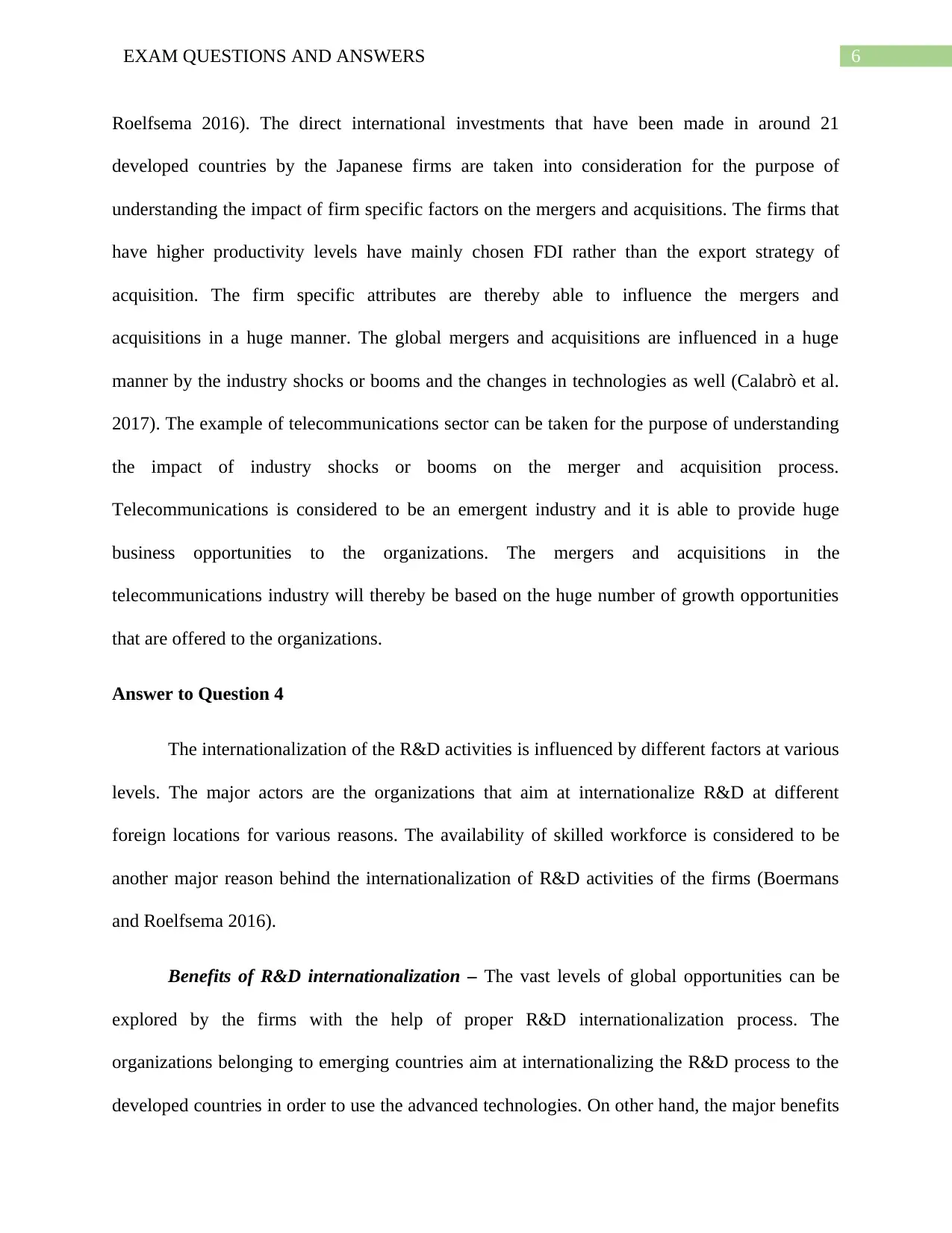
6EXAM QUESTIONS AND ANSWERS
Roelfsema 2016). The direct international investments that have been made in around 21
developed countries by the Japanese firms are taken into consideration for the purpose of
understanding the impact of firm specific factors on the mergers and acquisitions. The firms that
have higher productivity levels have mainly chosen FDI rather than the export strategy of
acquisition. The firm specific attributes are thereby able to influence the mergers and
acquisitions in a huge manner. The global mergers and acquisitions are influenced in a huge
manner by the industry shocks or booms and the changes in technologies as well (Calabrò et al.
2017). The example of telecommunications sector can be taken for the purpose of understanding
the impact of industry shocks or booms on the merger and acquisition process.
Telecommunications is considered to be an emergent industry and it is able to provide huge
business opportunities to the organizations. The mergers and acquisitions in the
telecommunications industry will thereby be based on the huge number of growth opportunities
that are offered to the organizations.
Answer to Question 4
The internationalization of the R&D activities is influenced by different factors at various
levels. The major actors are the organizations that aim at internationalize R&D at different
foreign locations for various reasons. The availability of skilled workforce is considered to be
another major reason behind the internationalization of R&D activities of the firms (Boermans
and Roelfsema 2016).
Benefits of R&D internationalization – The vast levels of global opportunities can be
explored by the firms with the help of proper R&D internationalization process. The
organizations belonging to emerging countries aim at internationalizing the R&D process to the
developed countries in order to use the advanced technologies. On other hand, the major benefits
Roelfsema 2016). The direct international investments that have been made in around 21
developed countries by the Japanese firms are taken into consideration for the purpose of
understanding the impact of firm specific factors on the mergers and acquisitions. The firms that
have higher productivity levels have mainly chosen FDI rather than the export strategy of
acquisition. The firm specific attributes are thereby able to influence the mergers and
acquisitions in a huge manner. The global mergers and acquisitions are influenced in a huge
manner by the industry shocks or booms and the changes in technologies as well (Calabrò et al.
2017). The example of telecommunications sector can be taken for the purpose of understanding
the impact of industry shocks or booms on the merger and acquisition process.
Telecommunications is considered to be an emergent industry and it is able to provide huge
business opportunities to the organizations. The mergers and acquisitions in the
telecommunications industry will thereby be based on the huge number of growth opportunities
that are offered to the organizations.
Answer to Question 4
The internationalization of the R&D activities is influenced by different factors at various
levels. The major actors are the organizations that aim at internationalize R&D at different
foreign locations for various reasons. The availability of skilled workforce is considered to be
another major reason behind the internationalization of R&D activities of the firms (Boermans
and Roelfsema 2016).
Benefits of R&D internationalization – The vast levels of global opportunities can be
explored by the firms with the help of proper R&D internationalization process. The
organizations belonging to emerging countries aim at internationalizing the R&D process to the
developed countries in order to use the advanced technologies. On other hand, the major benefits
Paraphrase This Document
Need a fresh take? Get an instant paraphrase of this document with our AI Paraphraser
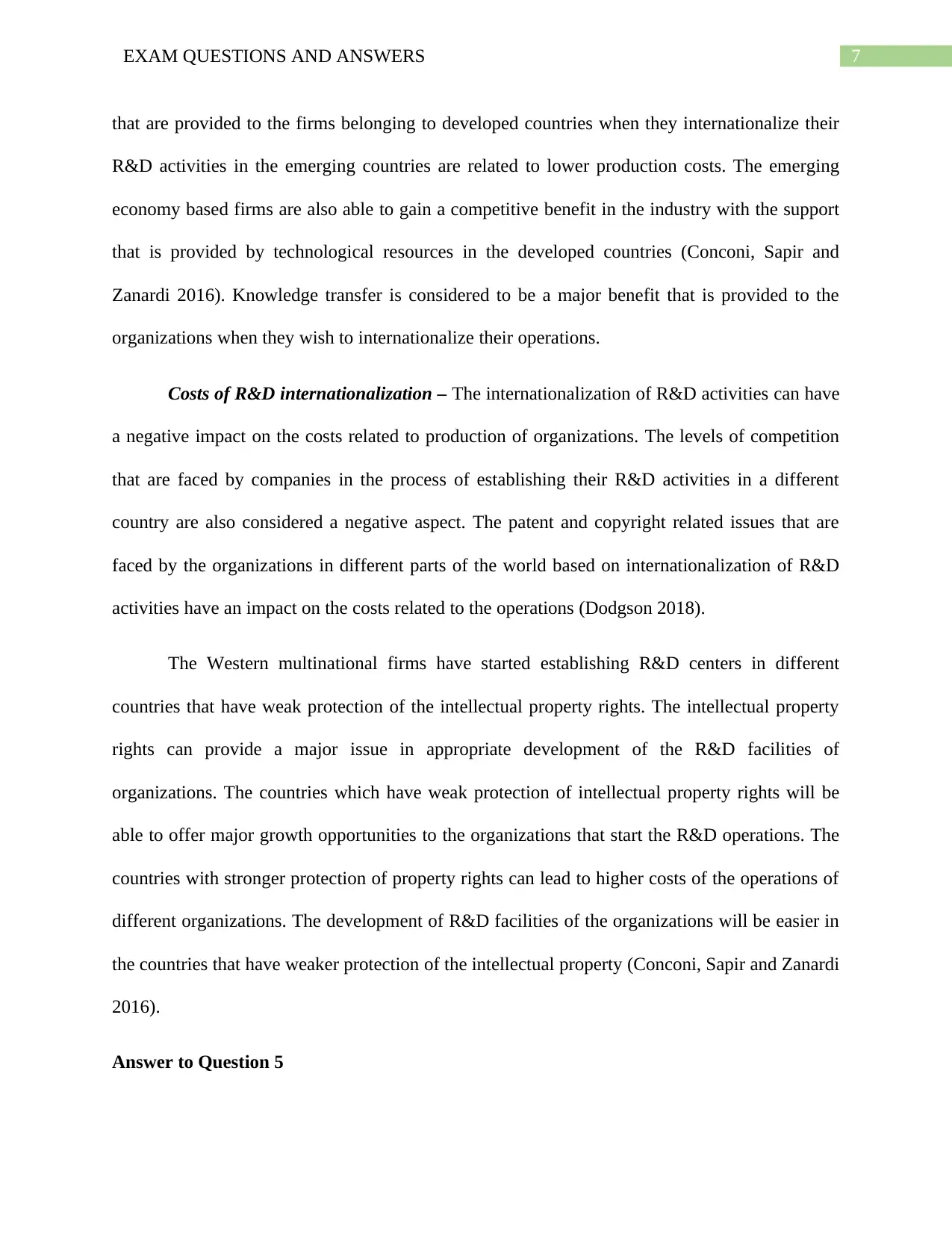
7EXAM QUESTIONS AND ANSWERS
that are provided to the firms belonging to developed countries when they internationalize their
R&D activities in the emerging countries are related to lower production costs. The emerging
economy based firms are also able to gain a competitive benefit in the industry with the support
that is provided by technological resources in the developed countries (Conconi, Sapir and
Zanardi 2016). Knowledge transfer is considered to be a major benefit that is provided to the
organizations when they wish to internationalize their operations.
Costs of R&D internationalization – The internationalization of R&D activities can have
a negative impact on the costs related to production of organizations. The levels of competition
that are faced by companies in the process of establishing their R&D activities in a different
country are also considered a negative aspect. The patent and copyright related issues that are
faced by the organizations in different parts of the world based on internationalization of R&D
activities have an impact on the costs related to the operations (Dodgson 2018).
The Western multinational firms have started establishing R&D centers in different
countries that have weak protection of the intellectual property rights. The intellectual property
rights can provide a major issue in appropriate development of the R&D facilities of
organizations. The countries which have weak protection of intellectual property rights will be
able to offer major growth opportunities to the organizations that start the R&D operations. The
countries with stronger protection of property rights can lead to higher costs of the operations of
different organizations. The development of R&D facilities of the organizations will be easier in
the countries that have weaker protection of the intellectual property (Conconi, Sapir and Zanardi
2016).
Answer to Question 5
that are provided to the firms belonging to developed countries when they internationalize their
R&D activities in the emerging countries are related to lower production costs. The emerging
economy based firms are also able to gain a competitive benefit in the industry with the support
that is provided by technological resources in the developed countries (Conconi, Sapir and
Zanardi 2016). Knowledge transfer is considered to be a major benefit that is provided to the
organizations when they wish to internationalize their operations.
Costs of R&D internationalization – The internationalization of R&D activities can have
a negative impact on the costs related to production of organizations. The levels of competition
that are faced by companies in the process of establishing their R&D activities in a different
country are also considered a negative aspect. The patent and copyright related issues that are
faced by the organizations in different parts of the world based on internationalization of R&D
activities have an impact on the costs related to the operations (Dodgson 2018).
The Western multinational firms have started establishing R&D centers in different
countries that have weak protection of the intellectual property rights. The intellectual property
rights can provide a major issue in appropriate development of the R&D facilities of
organizations. The countries which have weak protection of intellectual property rights will be
able to offer major growth opportunities to the organizations that start the R&D operations. The
countries with stronger protection of property rights can lead to higher costs of the operations of
different organizations. The development of R&D facilities of the organizations will be easier in
the countries that have weaker protection of the intellectual property (Conconi, Sapir and Zanardi
2016).
Answer to Question 5
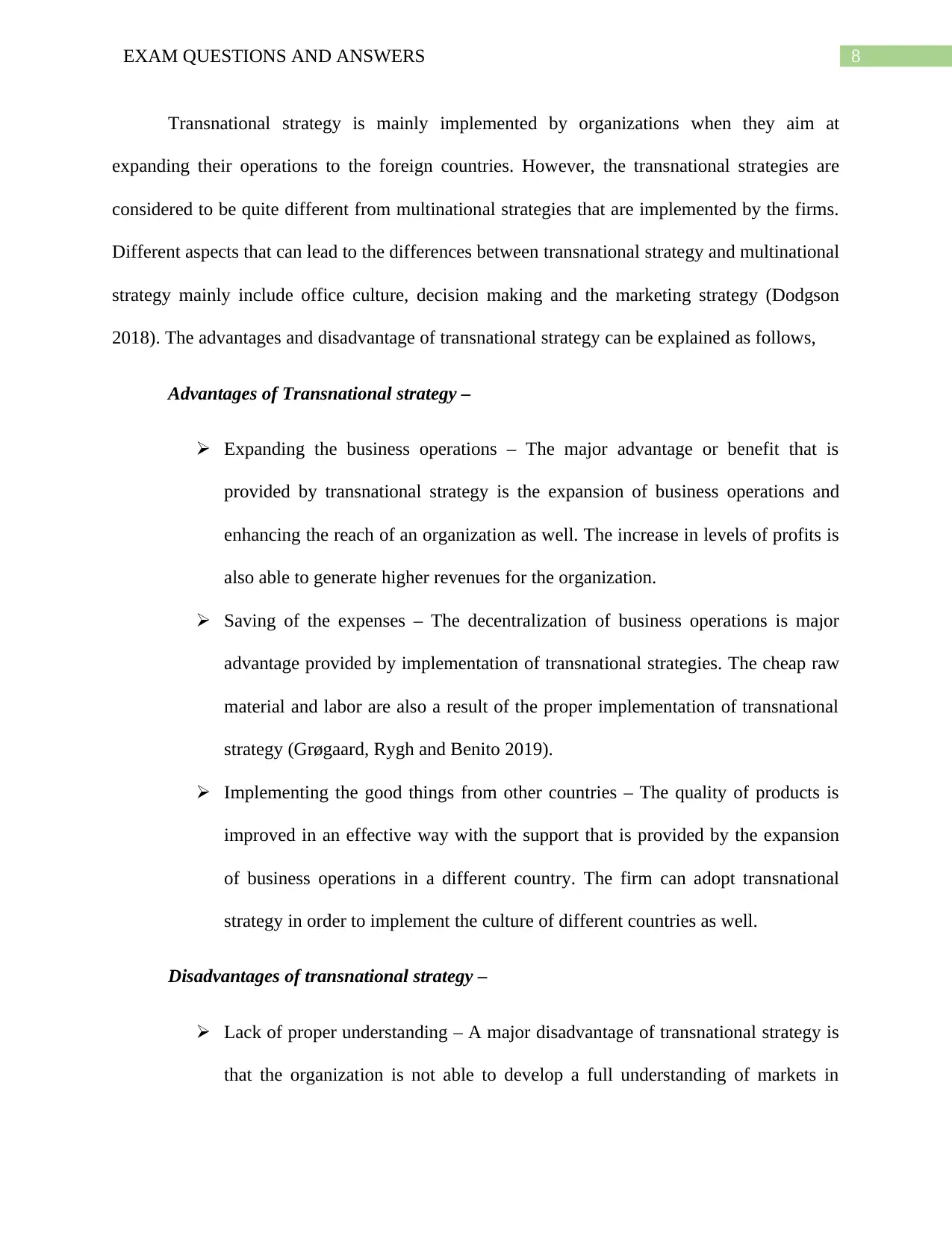
8EXAM QUESTIONS AND ANSWERS
Transnational strategy is mainly implemented by organizations when they aim at
expanding their operations to the foreign countries. However, the transnational strategies are
considered to be quite different from multinational strategies that are implemented by the firms.
Different aspects that can lead to the differences between transnational strategy and multinational
strategy mainly include office culture, decision making and the marketing strategy (Dodgson
2018). The advantages and disadvantage of transnational strategy can be explained as follows,
Advantages of Transnational strategy –
Expanding the business operations – The major advantage or benefit that is
provided by transnational strategy is the expansion of business operations and
enhancing the reach of an organization as well. The increase in levels of profits is
also able to generate higher revenues for the organization.
Saving of the expenses – The decentralization of business operations is major
advantage provided by implementation of transnational strategies. The cheap raw
material and labor are also a result of the proper implementation of transnational
strategy (Grøgaard, Rygh and Benito 2019).
Implementing the good things from other countries – The quality of products is
improved in an effective way with the support that is provided by the expansion
of business operations in a different country. The firm can adopt transnational
strategy in order to implement the culture of different countries as well.
Disadvantages of transnational strategy –
Lack of proper understanding – A major disadvantage of transnational strategy is
that the organization is not able to develop a full understanding of markets in
Transnational strategy is mainly implemented by organizations when they aim at
expanding their operations to the foreign countries. However, the transnational strategies are
considered to be quite different from multinational strategies that are implemented by the firms.
Different aspects that can lead to the differences between transnational strategy and multinational
strategy mainly include office culture, decision making and the marketing strategy (Dodgson
2018). The advantages and disadvantage of transnational strategy can be explained as follows,
Advantages of Transnational strategy –
Expanding the business operations – The major advantage or benefit that is
provided by transnational strategy is the expansion of business operations and
enhancing the reach of an organization as well. The increase in levels of profits is
also able to generate higher revenues for the organization.
Saving of the expenses – The decentralization of business operations is major
advantage provided by implementation of transnational strategies. The cheap raw
material and labor are also a result of the proper implementation of transnational
strategy (Grøgaard, Rygh and Benito 2019).
Implementing the good things from other countries – The quality of products is
improved in an effective way with the support that is provided by the expansion
of business operations in a different country. The firm can adopt transnational
strategy in order to implement the culture of different countries as well.
Disadvantages of transnational strategy –
Lack of proper understanding – A major disadvantage of transnational strategy is
that the organization is not able to develop a full understanding of markets in
⊘ This is a preview!⊘
Do you want full access?
Subscribe today to unlock all pages.

Trusted by 1+ million students worldwide
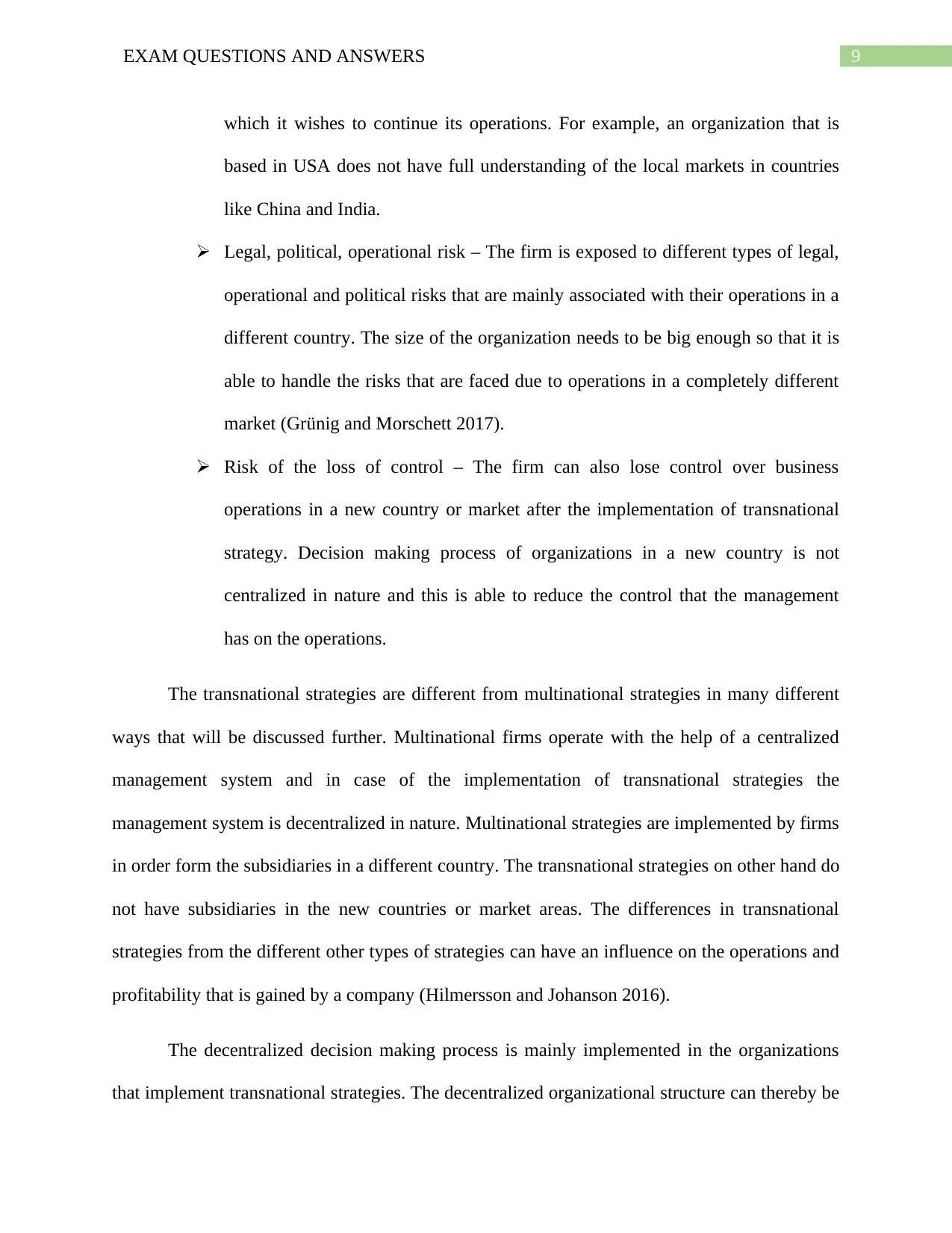
9EXAM QUESTIONS AND ANSWERS
which it wishes to continue its operations. For example, an organization that is
based in USA does not have full understanding of the local markets in countries
like China and India.
Legal, political, operational risk – The firm is exposed to different types of legal,
operational and political risks that are mainly associated with their operations in a
different country. The size of the organization needs to be big enough so that it is
able to handle the risks that are faced due to operations in a completely different
market (Grünig and Morschett 2017).
Risk of the loss of control – The firm can also lose control over business
operations in a new country or market after the implementation of transnational
strategy. Decision making process of organizations in a new country is not
centralized in nature and this is able to reduce the control that the management
has on the operations.
The transnational strategies are different from multinational strategies in many different
ways that will be discussed further. Multinational firms operate with the help of a centralized
management system and in case of the implementation of transnational strategies the
management system is decentralized in nature. Multinational strategies are implemented by firms
in order form the subsidiaries in a different country. The transnational strategies on other hand do
not have subsidiaries in the new countries or market areas. The differences in transnational
strategies from the different other types of strategies can have an influence on the operations and
profitability that is gained by a company (Hilmersson and Johanson 2016).
The decentralized decision making process is mainly implemented in the organizations
that implement transnational strategies. The decentralized organizational structure can thereby be
which it wishes to continue its operations. For example, an organization that is
based in USA does not have full understanding of the local markets in countries
like China and India.
Legal, political, operational risk – The firm is exposed to different types of legal,
operational and political risks that are mainly associated with their operations in a
different country. The size of the organization needs to be big enough so that it is
able to handle the risks that are faced due to operations in a completely different
market (Grünig and Morschett 2017).
Risk of the loss of control – The firm can also lose control over business
operations in a new country or market after the implementation of transnational
strategy. Decision making process of organizations in a new country is not
centralized in nature and this is able to reduce the control that the management
has on the operations.
The transnational strategies are different from multinational strategies in many different
ways that will be discussed further. Multinational firms operate with the help of a centralized
management system and in case of the implementation of transnational strategies the
management system is decentralized in nature. Multinational strategies are implemented by firms
in order form the subsidiaries in a different country. The transnational strategies on other hand do
not have subsidiaries in the new countries or market areas. The differences in transnational
strategies from the different other types of strategies can have an influence on the operations and
profitability that is gained by a company (Hilmersson and Johanson 2016).
The decentralized decision making process is mainly implemented in the organizations
that implement transnational strategies. The decentralized organizational structure can thereby be
Paraphrase This Document
Need a fresh take? Get an instant paraphrase of this document with our AI Paraphraser
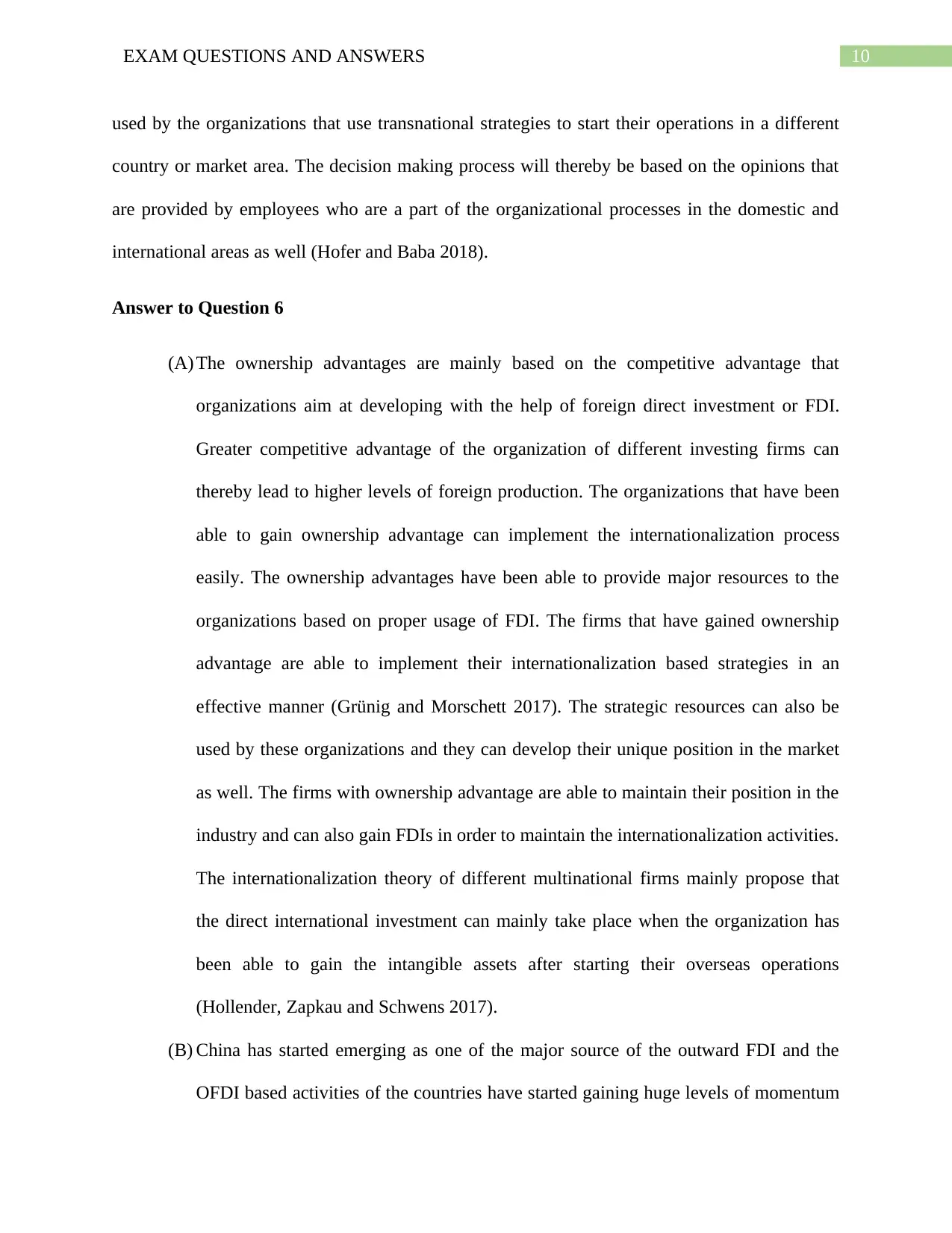
10EXAM QUESTIONS AND ANSWERS
used by the organizations that use transnational strategies to start their operations in a different
country or market area. The decision making process will thereby be based on the opinions that
are provided by employees who are a part of the organizational processes in the domestic and
international areas as well (Hofer and Baba 2018).
Answer to Question 6
(A) The ownership advantages are mainly based on the competitive advantage that
organizations aim at developing with the help of foreign direct investment or FDI.
Greater competitive advantage of the organization of different investing firms can
thereby lead to higher levels of foreign production. The organizations that have been
able to gain ownership advantage can implement the internationalization process
easily. The ownership advantages have been able to provide major resources to the
organizations based on proper usage of FDI. The firms that have gained ownership
advantage are able to implement their internationalization based strategies in an
effective manner (Grünig and Morschett 2017). The strategic resources can also be
used by these organizations and they can develop their unique position in the market
as well. The firms with ownership advantage are able to maintain their position in the
industry and can also gain FDIs in order to maintain the internationalization activities.
The internationalization theory of different multinational firms mainly propose that
the direct international investment can mainly take place when the organization has
been able to gain the intangible assets after starting their overseas operations
(Hollender, Zapkau and Schwens 2017).
(B) China has started emerging as one of the major source of the outward FDI and the
OFDI based activities of the countries have started gaining huge levels of momentum
used by the organizations that use transnational strategies to start their operations in a different
country or market area. The decision making process will thereby be based on the opinions that
are provided by employees who are a part of the organizational processes in the domestic and
international areas as well (Hofer and Baba 2018).
Answer to Question 6
(A) The ownership advantages are mainly based on the competitive advantage that
organizations aim at developing with the help of foreign direct investment or FDI.
Greater competitive advantage of the organization of different investing firms can
thereby lead to higher levels of foreign production. The organizations that have been
able to gain ownership advantage can implement the internationalization process
easily. The ownership advantages have been able to provide major resources to the
organizations based on proper usage of FDI. The firms that have gained ownership
advantage are able to implement their internationalization based strategies in an
effective manner (Grünig and Morschett 2017). The strategic resources can also be
used by these organizations and they can develop their unique position in the market
as well. The firms with ownership advantage are able to maintain their position in the
industry and can also gain FDIs in order to maintain the internationalization activities.
The internationalization theory of different multinational firms mainly propose that
the direct international investment can mainly take place when the organization has
been able to gain the intangible assets after starting their overseas operations
(Hollender, Zapkau and Schwens 2017).
(B) China has started emerging as one of the major source of the outward FDI and the
OFDI based activities of the countries have started gaining huge levels of momentum
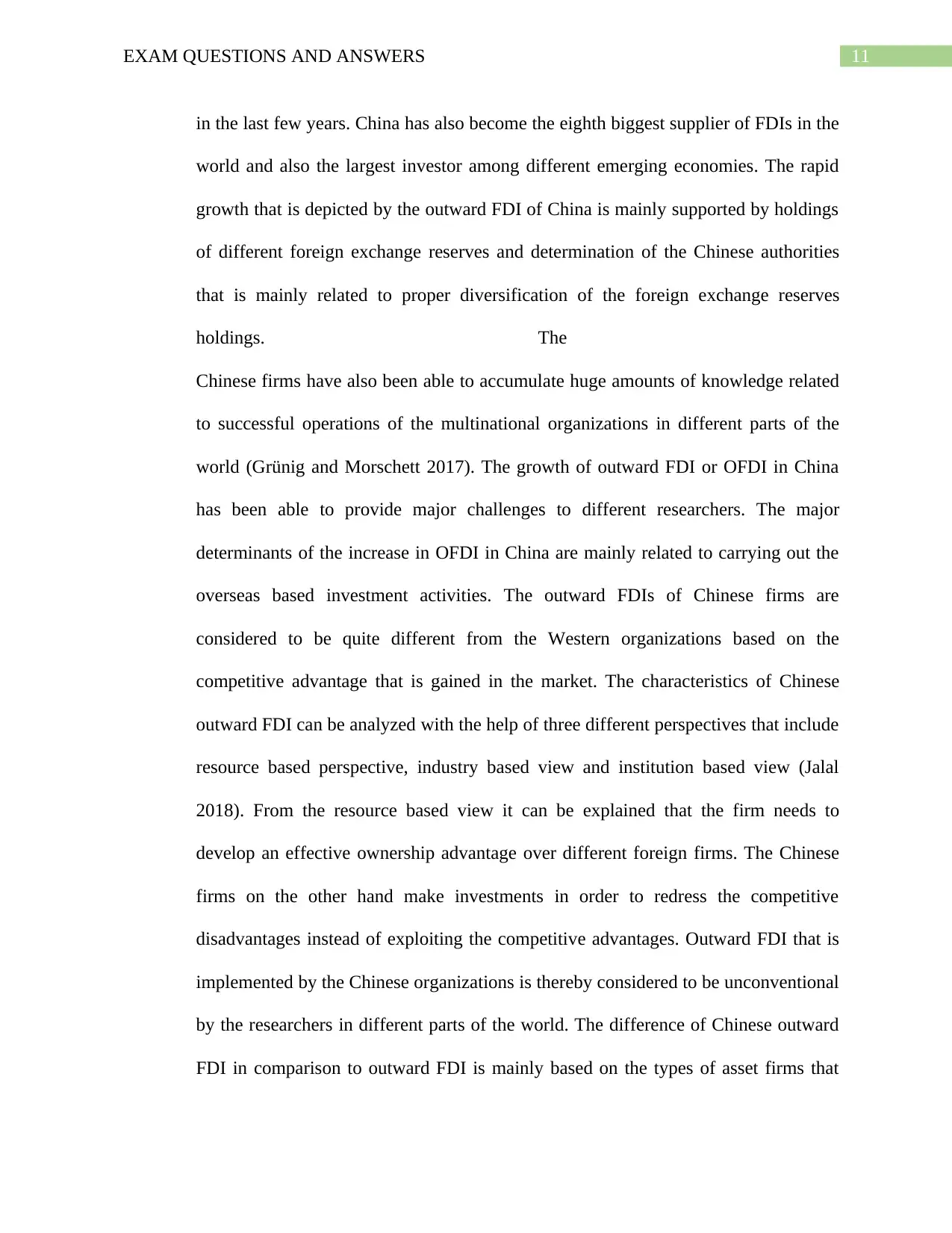
11EXAM QUESTIONS AND ANSWERS
in the last few years. China has also become the eighth biggest supplier of FDIs in the
world and also the largest investor among different emerging economies. The rapid
growth that is depicted by the outward FDI of China is mainly supported by holdings
of different foreign exchange reserves and determination of the Chinese authorities
that is mainly related to proper diversification of the foreign exchange reserves
holdings. The
Chinese firms have also been able to accumulate huge amounts of knowledge related
to successful operations of the multinational organizations in different parts of the
world (Grünig and Morschett 2017). The growth of outward FDI or OFDI in China
has been able to provide major challenges to different researchers. The major
determinants of the increase in OFDI in China are mainly related to carrying out the
overseas based investment activities. The outward FDIs of Chinese firms are
considered to be quite different from the Western organizations based on the
competitive advantage that is gained in the market. The characteristics of Chinese
outward FDI can be analyzed with the help of three different perspectives that include
resource based perspective, industry based view and institution based view (Jalal
2018). From the resource based view it can be explained that the firm needs to
develop an effective ownership advantage over different foreign firms. The Chinese
firms on the other hand make investments in order to redress the competitive
disadvantages instead of exploiting the competitive advantages. Outward FDI that is
implemented by the Chinese organizations is thereby considered to be unconventional
by the researchers in different parts of the world. The difference of Chinese outward
FDI in comparison to outward FDI is mainly based on the types of asset firms that
in the last few years. China has also become the eighth biggest supplier of FDIs in the
world and also the largest investor among different emerging economies. The rapid
growth that is depicted by the outward FDI of China is mainly supported by holdings
of different foreign exchange reserves and determination of the Chinese authorities
that is mainly related to proper diversification of the foreign exchange reserves
holdings. The
Chinese firms have also been able to accumulate huge amounts of knowledge related
to successful operations of the multinational organizations in different parts of the
world (Grünig and Morschett 2017). The growth of outward FDI or OFDI in China
has been able to provide major challenges to different researchers. The major
determinants of the increase in OFDI in China are mainly related to carrying out the
overseas based investment activities. The outward FDIs of Chinese firms are
considered to be quite different from the Western organizations based on the
competitive advantage that is gained in the market. The characteristics of Chinese
outward FDI can be analyzed with the help of three different perspectives that include
resource based perspective, industry based view and institution based view (Jalal
2018). From the resource based view it can be explained that the firm needs to
develop an effective ownership advantage over different foreign firms. The Chinese
firms on the other hand make investments in order to redress the competitive
disadvantages instead of exploiting the competitive advantages. Outward FDI that is
implemented by the Chinese organizations is thereby considered to be unconventional
by the researchers in different parts of the world. The difference of Chinese outward
FDI in comparison to outward FDI is mainly based on the types of asset firms that
⊘ This is a preview!⊘
Do you want full access?
Subscribe today to unlock all pages.

Trusted by 1+ million students worldwide
1 out of 27
Related Documents
Your All-in-One AI-Powered Toolkit for Academic Success.
+13062052269
info@desklib.com
Available 24*7 on WhatsApp / Email
![[object Object]](/_next/static/media/star-bottom.7253800d.svg)
Unlock your academic potential
Copyright © 2020–2025 A2Z Services. All Rights Reserved. Developed and managed by ZUCOL.





